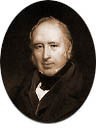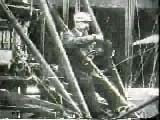About

FirstFlight was part of a research project concerned with the development of virtual science environments.
It was led by the late Dr Peter Whalley with graphic elements of simulations & movies by Jon Linney; Adobe Shockwave programming by: Dr Kevin Quick and recreated movie by Jon Linney & Shamus Foster.
The original simulators sadly no longer run as they required Adobe Shockwave, which is a format no longer supported by browsers.
Flyers
Cayley

Sir George Cayley has been described as the ‘Father of Aerial Navigation’. One hundred years before the Wright Brothers he had developed the first proper understanding of the principles of flight and constructed a series of models to prove his ideas. In 1853, fifty years before the first powered flight was made at Kitty Hawk, the first man-carrying glider flight was made across Brompton dale in the north of England by Cayley’s coachman.
Cayley defined the form of the present-day aeroplane by breaking away from the previous ideas of how powered flight would be achieved. The drawing he made on a silver disc in 1799 shows a machine with a fixed wing, a fuselage, and a tail. It also had separate systems to provide lift, propulsion and control. Cayley later tried to develop the ‘prime mover’ that he realised would be needed for powered flight, but unfortunately his gunpowder engines were not reliable.

He carried out the first serious, experimentally based aeronautical research, and the reverse side of the disc shows Cayley’s analysis of the forces on a wing surface into lift and drag components. This represented a significant step in our understanding of flight, and in 1804 Cayley followed it up with experiments using a ‘whirling arm’, the first ever scientific testing of aerofoils.

(Image of the original Adobe Shockwave based flight simulator)
Lilienthal

Otto Lilienthal is one of the key figures in the history of flight. He has been described as “the worlds’ first true aviator” and his results and methods were an inspiration to many other pioneers, particularly the Wright Brothers. He was the first to realise that the only way to gain essential experience in design and control was to first learn how to glide and used to launch himself from an artificial hill near Berlin or from the Rhinower Hills.

(Image of the original Adobe Shockwave based Lilienthal’s Whirling Arm simulator)
Lilienthal focussed on the canopied form of bird wing, rather than attempting to develop the cambered aerofoil, and just before his death had even completed a glider with motor driven wingtips. However, his scientific work with whirling-arm experiments formed the basis of all subsequent aerodynamic investigations.
Lilienthal’s death was untimely and had a profound effect on the history of flight. Whilst flying one of his older gliders in 1896, he was struck by a gust of wind. The nose of the machine was forced up, he was not able to control the resulting stall, and fell from 15m breaking his spine.
Like Cayley, Lilienthal remained convinced that the first powered aircraft would be an ornithopter. He had demonstrated that birds produce thrust by the propeller action of their outer feathers, and just before his death had completed a glider with ornithopter wingtips operated by a small carbonic-acid gas motor. As with Cayley’s ‘flappers’, they did not work well in ground trials and it is unlikely that they would have worked in flight, but maybe…
Phillips

Horatio Phillips is now best known for his patented ‘double surface aerofoil’ sections. His results and designs were republished by Chanute, and almost certainly influenced the Wright Brother’s understanding of their own wind tunnel data.


Phillips built a wind tunnel which used steam injection to create the airflow. In 1884 he patented a series of curved aerofoils designed:
in such a way as to as to cause a partial vacuum to be created over a portion of the upper surface of the blade thus aiding the air below to support the weight.
Phillips took the idea of high aspect ratio wings to its absolute extreme. His steam powered models & man carrying planes have been described as ‘flying venetian blinds’, and even as a ‘flying runner bean frame’. His 1904 plane made only a brief hop, but the 1907 construction made a ‘flight’ of 500ft at Steatham, the first powered hop in England.

The Wright Brothers

Controlled, powered flight had seemed impossible until Orville Wright took off on the 17th December 1903. The key to the Wright Brother’s success was that their engineering had gone beyond the trial and error methods of their contemporaries. Having only very limited resources they showed great scientific ingenuity.
When their test flights did not produce as much lift as they had expected, they went back to first principles and carried out a series of scientific experiments, starting with the bicycle balance and moving onto their famous wind tunnel experiments.

(Image of the original Adobe Shockwave based bicycle balance simulator)
Experiments with the bicycle balance in 1901 convinced the Wright Brothers that they had been using the wrong value for one of the key constants in their calculations. They had based their designs on tables for the coefficient of lift derived from work by the pioneering German aviator Lilienthal, but now they realised that these tables were wrong. The data from Lilienthal’s experiments had been correct but it had later been reinterpreted and published using calculations that assumed a value for Smeaton’s coefficient that was too high.
They were the first to understand how the lift from the aerofoil changes in flight, and the first to design their propellers as a form of aerofoil.
The design of the lift balance allowed the Wrights to measure the lift coefficient directly.

By making a sequence of readjustments to the balance they were able to factor out the drag force of the model wing. Their results were independent of both the Smeaton’s coefficient and the air flow velocity, a great advance on previous scientific experiments.
Now that they could measure the lift coefficient, the Wrights designed the drift balance to directly measure the drag to lift ratio.

This allowed them to calculate the drag coefficient of their model aerofoils. The Wright Brothers were able to develop a much better understanding of how the shape of a wing determined its aerodynamic properties than anyone before them, and this led to the improved performance of their planes after 1902.
The Wright Brothers designed the 1903 Flyer to protect themselves from injury whilst they learnt to fly. Their canard design was safer in a stall but difficult to control.
Santos-Dumont

The wealthy young Brazilian Alberto Santos-Dumont used Paris as a stage for his aeronautical exploits with airships and planes. For several years he was internationally acclaimed as the first man to have achieved powered flight. However, as the earlier efforts of the Wright Brothers became generally accepted his exploits were recognised as having been only the first powered flight in Europe.

On the 22nd October 1906 Santos-Dumont made a flight of about 60 metres at a height of 2 to 3 metres. Three weeks later on 12th November he made four more flights, the longest being of 220 metres at a height of one metre and lasting 21 seconds.

The name Santos is now best known for the wristwatch, made for him by his friend Louis Cartier to help with his ballooning adventures. The dare-devil reputation and popularity of Santos-Dumont in Paris helped to lead a change in fashion for men from pocket watch to wristwatch.
Cody

Samuel Cody, a US citizen, built the British Army Aeroplane No. 1 in 1908 and flew it on three occasions at Farnborough in that year. The plane had a 50HP Antoinette engine and twin chain-driven propellers. Cody’s canard biplane did not contribute technically to aviation but was significant in maintaining a public and military interest in flying.
He flew 304 feet on 29th Sept and 200 feet on the 14th Oct. On the third and final flight on October 16th he flew 1390 feet. The flight ended when the wing touched the ground as Cody attempted to turn, and the machine crashed. This has been taken to be the first powered flight made in England, although Phillips had made a short hop in 1904, and a longer hop of 500 feet in 1907.


For the original simulation the instructions where: “To fly the simulation simply click on the control wheel. move your mouse backwards and forwards to control the canard. When you crash click again to return to the take-off point. The model assumes slight pitch instability from the canard configuration. The best starting strategy is to try to keep the horizon midway between the engine and the fuel tank.”